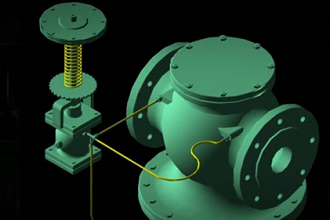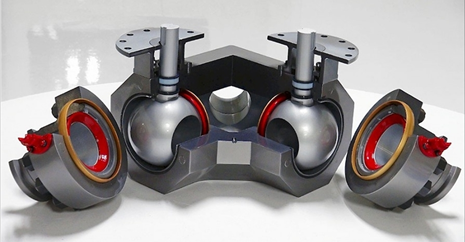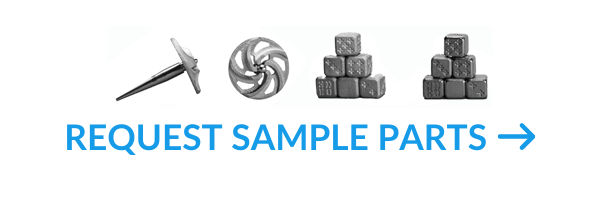 As new products are designed, including valve bodies and the parts that comprise the finished valve, prototypes must be created. How that is achieved is what makes the difference in how long it takes to get development done and the product to market.
As new products are designed, including valve bodies and the parts that comprise the finished valve, prototypes must be created. How that is achieved is what makes the difference in how long it takes to get development done and the product to market.
Prototyping is exceptionally challenging in the valve industry due to the complex, multi-component parts. In the past, all these components would require a full set of custom tooling to prototype. According to Jeff Kane at DFT Valves, tooling is hugely time-consuming and expensive for valve prototyping.
It takes time to create the tools, then build the parts and see if the design works properly the first time. If not, revisions could take many more weeks—anywhere from several weeks to as much as six months, and the cost could be upwards of $500,000 to get a valid prototype. Then the prototype would have to go through testing, validation and verification.
Now, rapid prototyping, which could include CNC (Computer Numerically Controlled) machining, injection molding and most recently, 3D printing, has made an enormous difference in the time and money required to turn an idea into a marketable product.
WHICH METHOD TO USE?
In a recent webinar, Tony Holtz of Protolabs outlined several factors to consider when deciding which prototyping method to use.
1) How many parts do you need?
2) What types of material characteristics do you require for the prototype and, ultimately, the product?
3) What is your budget?
4) When do you need the parts? Whether you need them now or in a few weeks will help determine which process to use.
5) In what stage of product development are you?
6) Will you likely need to make modifications? If so, then you might want to start off with the lower risk of 3D printing.
7) What is the life expectancy of this product?
8) Are you familiar with the options? There is also investment casting, and that can also serve a purpose. You must weigh out your options.
3D PRINTING OR ADDITIVE MANUFACTURING
3D printing is evolving rapidly, with new processes and materials appearing, it seems, almost weekly. With many options now available, it is possible to create prototypes using just one, or several methods.
 Figure 1. In this demonstration valve model, three different methods of 3D printing were used: The body of the valve was created using fuses deposition modelling. The o-rings were made of a rubber-like material and created by polyjet printing. The bolts were created with stereolithography. (Photo used with permission and technical assistance provided by 3D Print Texas.)
Figure 1. In this demonstration valve model, three different methods of 3D printing were used: The body of the valve was created using fuses deposition modelling. The o-rings were made of a rubber-like material and created by polyjet printing. The bolts were created with stereolithography. (Photo used with permission and technical assistance provided by 3D Print Texas.)
Stereolithography (SLA)
This method has the greatest choice of materials and the best feature resolution. It also has the smoothest surface finish and is great for very small parts and complex geometries. It utilizes a resin-like material, so products made this way will not be long-lasting like a thermos-plastic, but there are several choices of feedstock strengths, transparencies and temperature resistance.
The finishing options, which can add longevity, can also make a prototype made with SLA look more like the actual product will appear.
Selective Laser Sintering
True thermoplastic material is used, which can be comparable to an injection-molded product. It can take much more abuse and last longer. Depending on the quantities, it could potentially be used as end-use products when you are trying to reduce the number of components or weight of an item. You can 3D print any geometry imaginable, which you cannot do with a CNC machine or injection molding.
Polyjet
This is more of a resin-like material with uses like concept verification, presentation models and design verification. This process prints in the widest variety of materials, and models can be precisely printed in layers as fine as 16 microns. Material properties range from rubber to rigid, transparent to opaque, neutral to vibrantly colored and standard to biocompatible, and more than one material can be present in one product. You can truly simulate the form, fit and function of a finished product.
Direct Metal Laser Sintering
For very small and complex part geometry, unique designs can be 3D printed with metal. This is especially popular in the aerospace or medical industries as geometries can be hollowed out to reduce weight.
Material properties of direct metal laser sintering are very similar to CNC machining materials. Aluminum, titanium, stainless steel and cobalt chrome can all be used in direct metal laser sintering. The cost depends on how many parts can be built on a single build.
Intelligent Layering
A new process has recently been rolled out by 3DEO in California. Called “Intelligent Layering” by its developers, this process involves six steps as shown in Figure 2. According to materials released by the company, the production cost for this process is lower than many other forms of 3D printing because the machine itself is lower cost, and finishing occurs as the product is made. This cuts down the time required to finish the product and take it to market, and makes it possible to produce greater volumes of products, something which is difficult to do in more traditional forms of 3D printing.
 Figure 2. Intelligent Layering is a new, lower cost form of metal 3D printing that makes it possible to manufacture higher volumes of products at reasonable cost.
Figure 2. Intelligent Layering is a new, lower cost form of metal 3D printing that makes it possible to manufacture higher volumes of products at reasonable cost.
The products created with this technology comply with MPIF Standard 35, which is a standard developed by Metal Powder Industries Federation (MPIF).
According to Matt Sand, president of 3DEO, adhering to an existing industry standard allows the company’s parts to be immediately used in production wherever that standard is currently accepted. Because this is a completely new process, it is important to assure engineers and supply chain managers that the part created in this new way would meet the traditional standards required for that part.
When choosing which 3D method to use for prototyping, it’s important to consider and compare the material properties—including the tear strength, elongation break and hardness of the resins—to production-grade material.
CNC (COMPUTER NUMERICALLY CONTROLLED) MACHINING
According to Holtz, when comparing 3D printing to CNC, the main criteria for choice is the quantity of parts, the lead time and the costs. Parts can be done in plastics and metals and CNC machining can also use actual thermoplastic materials as well as hard and soft metals such as aluminum, copper, brass and stainless steel. CNC machining can be used for one-off prototypes, end-use functional parts and jigs and fixtures. CNC machining is generally faster than 3D printing and is better for larger volumes of parts.
CNC machining can be very precise and CNC mills can make thousands of perfect copies of an object very quickly. CAD programs can be used to design a part and that design can be seamlessly used to program the CNC mill to create the part at relatively low cost. The downside to CNC milling is that the machines themselves are very expensive and must be rigorously maintained. While larger manufacturers will have CNC machines of their own, smaller operations would likely need to outsource the project.
When deciding between CNC and 3D printing, also consider the part geometry and the number of products needed to determine which is more economical.
INJECTION MOLDING
There are various types of injection molding, including plastic injection molding and liquid silicone rubber molding. The chosen process will be determined by the quantity and complexity of the part. Injection molding is suitable for quantities of 25 to over 10,000 components.
With injection molding, many parts can be created and produced at the same time quickly, with low labor costs and a high repeat tolerance. Generally, there is little finishing required as parts usually have a finished look upon ejection.
This is a good process for prototyping, bridge tooling and low-volume product. There are hundreds of colors and engineering-grade plastics available for injection molding. Liquid silicone rubber is strong and elastic with excellent thermal, chemical and electrical resistance and can near-perform glass materials in some applications. It does not yellow like many acrylics.
Other options for creating plastic prototypes include overmolding, a process whereby a single part is created using two or more different materials in combination, and insert molding, the process of molding or forming plastic parts around other, non-plastic parts.
CHOOSING YOUR PROTOTYPE DESIGN
While 3D printing and CNC machining can be valuable for prototyping, lead times and costs are not the only criteria. While you can often make much more intricate parts with these methods, you might not be able to mass manufacture the parts that result. It’s essential to confirm and modify specifications depending on the complexity and finish you will require for the manufactured product.



